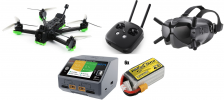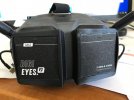There is not a single thing in this description that would cause me to get anything "other" than the
DJI FPV. This sounds exactly like the "compromise" that I want.
Below is from a channel that's not biased towards Acro Quads ... he does equal much content about Photo Drones from DJI & Autel, so would say he's general opinion is fairly neutral.
When I got into the Acro Quad side of flying the reason was that I was more drawn towards the "flying" side, more than towards the "Photography/Videoing" side ... I wasn't out to get another "Photo Drone" with some kind of Acro Quad flavor ... & further more in a fragile design belonging to the DJI eco system regarding expensive accessories.
Many bring up that the
DJI FPV drone gives up to 20min. flight times ... much longer than a Acro Quad. But this is a twisted truth, yeah you can get those flight times but only if you use it in ordinary GPS mode as a Photo Drone. Going for full manual (acro) you will be seeing 7-10min max which is on par with Acro Quads.
All this with safety features then ... RTH, GPS, stabilized flight modes, height hold & hovering in place? Well yeah, the
DJI FPV drone have an equal amount of safety features as an ordinary Photo Drone ... if it's used in the "Photo Drone" modes.
Today a Acro Quad have reached a much better level of these "assisting" functions ... if you have a GPS chip on your Acro Quad you will have a simpler form of RTH, either by button or if losing the connection. You also have access to 2 other modes beside full manual mode (acro mode) ... in Horizon mode the Quad auto stabilize horizontally if the sticks are released, but you don't have a tilt angle limit so you can do full flips & rolls. In Angle mode the Quad acts very much as a Photo Drone ... & will not tilt more than a predefined tilt angle & with stick release it will auto stabilize horizontally.
So the safety or assistance features you miss out from a Acro Quad is auto height hold ... you always need to adjust the throttle to hold the height you desire. And it will not hold GPS position during a hover ... you as a pilot need to make adjustments in roll & pitch to keep it in position & fight wind. So if the Acro Quad is in Angle mode it will act exactly as a Mavic in ATTI mode ... without height hold.
Price wise then ... wouldn't a
DJI FPV drone kit be cheaper instead of buying all separate parts?
Well ... not true, & especially not in the long run with all the "special" DJI accessories only intended for the
DJI FPV drone.
This Acro Quad kit below (with the DJI digital system) have approx the same price tag as the
DJI FPV drone kit ...

Going with this gives you the possibility to add in another Acro Quad if you want (larger or smaller) ... but still continue to use the same
Goggles, Controller, Charger & Batteries.
Do you want max performance regarding speed & agility ... buy smaller LiPo high C-rated batteries & get flight times between 5-10min with aggressive flying carrying a GoPro. Want to cruise like a fixed wing & enjoy the scenery ... buy large LiIon batteries & get flight times between 20-30min... all on the same craft.
OK ...what about soldering, fiddling with small electronic components, flight controllers & ESC's ... all the needed adjustments you need to do in the firmware?
Not anything of that is needed ... the Acro Quad in the picture above is bought as "Bind & Fly", meaning all is built & all is adjusted in the firmware for the best flight performance, just plug in the battery & fly. If something breaks you can easily swap out a single component yourself & be good with it ... think's it has a tad to much prop wash when you come in & down with speed, then you CAN adjust settings to get a more suitable performance to your flying style.
The only reason I see, that speaks for the
DJI FPV drone ... is if you want to consolidate & have both a mediocre photo drone & a mediocre acro quad in the same craft.
Without a doubt I would go for a proper "Photo Drone" for the best photography ... & a separate "Acro Quad" for the best flight experience.
And to answer your initial question about several
goggles & spectators ... yeah, it's possible if using channel 8 (spectator) in the
goggles on 25Mbit bitrate ... with a Acro Quad. Don't know if it's the same with the
DJI FPV drone though.













